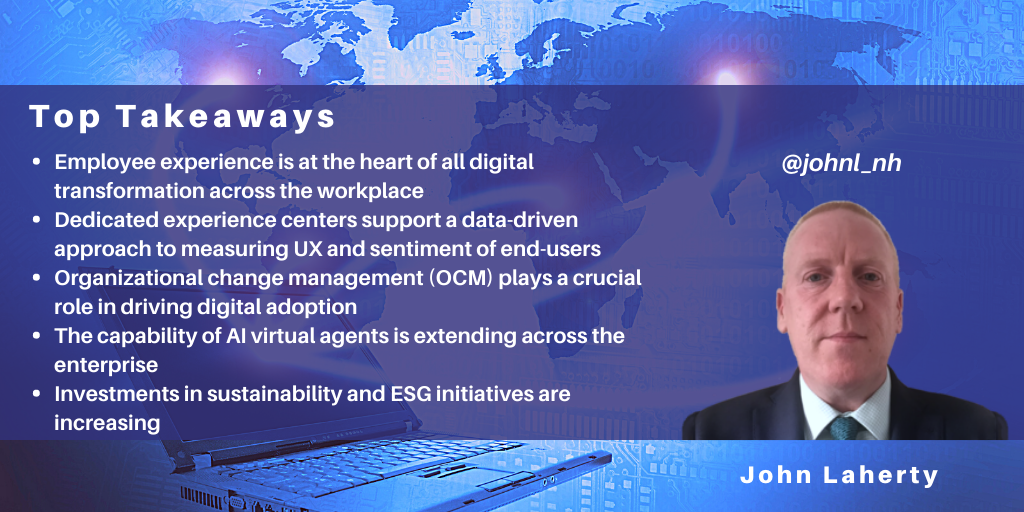posted on Mar 31, 2022 by John Laherty

NelsonHall recently completed an in-depth analysis of advanced digital workplace services, in which we spoke to multiple leading IT services vendors and their clients. This blog looks at some of the key themes from this research, the investments vendors need to make to meet client demand, and how the market will evolve over the next 12 to 18 months.
The three overarching themes from this study were:
- Applying a human-centric approach and placing employee experience at the center of everything
- Enhancing digital support and increasing predictability of services
- Ramping digital re-skilling and empowering end-users.
Let’s look at these key focus areas in more detail.
Employee experience is paramount
In addition to the recent market analysis, NelsonHall carried out a study of multiple IT stakeholders across industries. Here, 91% identified digital workplace services as highly important in improving the employee experience and supporting new hybrid ways of working across the enterprise. In addition, 93% rated greater personalization of services as key to improving collaboration in support of hybrid working. Within employee experience, the main sub-themes we identified included:
> Identifying and measuring employee experience and establishing roadmap (includes the use of analytics and dedicated experience centers)
Vendors need to support their ability to drive the customer experience by continuing to invest in end-user analytics tools to measure employee sentiment and performance, with typical tools including 1E Tachyon, Nexthink, SysTrack, and Qualtrics. These measure UX across devices, applications, networks, and home-office WiFi environments. We expect to see more use of Microsoft Viva through APIs to measure employee HR, wellbeing, cultural sentiment, and combining this with sentiment analytics and measuring across dedicated experience frameworks.
Over the next 12 months, focus on dedicated experience centers will increase, supported by SRE teams that look at the experience aspect of IT service delivery and proactively monitor the sentiments of end-users as they engage across services and XLAs (and work with clients to create specific XLAs by persona).
> Delivering employee experience (through personalization and holistic experience)
Here, vendors should look to enable a hyper-personalized approach at the start of client engagements to understand clients’ business and customize solutions accordingly. Also, it is essential to define personas by industry and personalized experience services across the workplace and wider enterprise ecosystem.
Also, it is important to focus on providing a holistic experience in both physical and virtual environments to drive location-independent collaboration in support of hybrid working. This will increasingly involve the deployment of AR/XR, including Microsoft Mesh Services and HoloLens.
Overall, it is now critical for organizations to provide a holistic employee experience, with experience parity between working from home, office, and other locations in support of hybrid working collaboration.
Other key investment areas include building XLAs to support business outcomes (e.g., automation effectiveness, virtual agent effectiveness, accurate technical resolution, chat uptake, self-service, and knowledge article first-time resolution).
> User training (use of MarTech and Microsoft Viva)
We expect to see more investment in MarTech, used for contextualizing the workplace for users, targeting ads to an end-user in an enterprise for training and adoption services, and continuing focus on OCM to drive digital adoption. User learning will be further enhanced by greater utilization of Microsoft Viva and targeting installed M365 client bases with Viva to improve productivity and UX.
Driving predictability across the workplace through digital support services
Vendors are increasing investments in proactive and predictive support services, including AI-led service desks, to facilitate the move to a fully automated ‘zero-touch’ service desk capability. They need to provide end-users with access to digital support through a single touchpoint (e.g., Teams). Within self-serve, vendors need to increase the resolution capability of virtual agents and integrate self-heal capabilities to enable greater self-remediation of issues. It includes self-heal scripts and self-help libraries, including one-click automated solutions, knowledgebase articles, and targeting self-healing at L0, L1, and L1.5 incidents. This is supported by utilizing data from the log files of the different devices deployed across the workplace and aggregating this data to view patterns. This is used to trigger actions to propose preventative measures to improve configuration and predict, prevent, detect, and fix potential issues before they reach the service desk.
Automation is key in:
- Direct automation of incidents, driving continuous transformation through a data-driven approach and automating the bulk of L1 incidents
- User support, extending AI virtual agents across the enterprise (e.g., in HR for onboarding and offboarding), facilities management, and procurement functions.
Over the next 12 months, we anticipate more focus on AIOps and the interoperability with existing and new environments through a catalog-based service and bot store for reusable automation assets. As more insights are gained across the end-user environment through analytics, ML, and AI, it enables greater adoption of self-healing technologies and auto-remediation capabilities. It will improve predictability across IT environments, rectify issues before an end-user realizes they have an issue, and support the transition to a future No-Ops model.
Digital re-skilling continues at pace
We continue to see traction in digital re-skilling initiatives and hyperscaler certifications supporting digital workplace services. We are seeing a shift from traditional L1/2/3/mindsets to a real-time data insights-driven approach supported by site reliability engineers (SRE) approving machine recommendations. New skillsets are emerging, including machine coaches developing algorithms for AIOps systems, business value specialists, experience and innovation leads, automation, and AI architects.
Over the next 12 to 18 months, we expect to see more focus on end-user empowerment using low code/no-code platforms and managing M365 through the Microsoft Power Platform. Vendors also need to expedite resources, building automation use cases and system capability by industry to meet clients’specific business needs. There is also an opportunity for vendors to hire from a much larger digital skills pool than previously, driven by remote working.
There will also be more focus on Evergreen-as-a-Service, and supporting SMEs enabling clients to keep up to date with the latest features and updates from hyperscalers and the provision of advisory services through Evergreen CoEs to help clients adopt new features and transform the way end-users work. This includes greater utilization of modern management to provide a centralized solution for all devices, including PCs, tablets, IoT devices, smartphones, and Macs, bringing all endpoint management together into a single unified service to manage all devices from one solution. Invariably, cloud-based management toolsets will manage the full lifecycle of all endpoints from onboarding to retirement.
Outlook
Investment in digital workplace services will continue at pace, driven by the need to enhance the employee experience and the opportunities created by digital support services, SaaS (M365 and Intelligent Collaboration tools), VDI, and AR/VR. We anticipate increasing adoption of fully-cloud-based digital workplace platforms driven by ongoing hybrid remote working requirements.
In addition, we expect to see more investment in decarbonization measurement, including reducing onsite support to benefit carbon emissions and utilizing Green apps to give end-users visibility of their carbon footprint. This will also include avoiding costs related to unused hardware and engaging and educating employees to influence sustainable practices.
5G, edge technologies, and IoT-enabled solutions, including health testing and biometric building entry, and voice and gesture control, have a key role in facilitating a safe return to the office. These technologies are often integrated with third-party platforms, particularly the ServiceNow safe workplace suite.
Overall, the transformation of digital workplace services will be underpinned by increased uptake of Windows 365 Cloud PC, Windows 11, Apple DaaS, and modern management toolsets. In addition, there will be more focus on joint IP and GTM initiatives with hyperscalers in support of hybrid working environments.
Find out more about NelsonHall’s ‘Advanced Digital Workplace Services’ market assessment report here or contact Guy Saunders.


